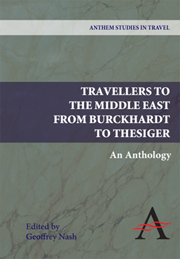Book contents
- Frontmatter
- Contents
- Acknowledgements
- Introduction
- PART ONE THE COMING OF EMPIRE 1800–1879
- The Ottoman Empire and Egypt
- Arabia
- Persia
- 1 A Journey through Persia, Armenia and Asia Minor
- 2 Sketches of Persia
- 3 Travels in the Persian Provinces of the Caspian
- 4 Glimpses of Life and Manners in Persia
- 5 Travels in Central Asia
- 6 Early Adventures in Persia, Susiana and Babylonia
- PART TWO COLONIALISM AND RESISTANCE 1880–1950
- Bibliography
5 - Travels in Central Asia
from Persia
Published online by Cambridge University Press: 05 March 2012
- Frontmatter
- Contents
- Acknowledgements
- Introduction
- PART ONE THE COMING OF EMPIRE 1800–1879
- The Ottoman Empire and Egypt
- Arabia
- Persia
- 1 A Journey through Persia, Armenia and Asia Minor
- 2 Sketches of Persia
- 3 Travels in the Persian Provinces of the Caspian
- 4 Glimpses of Life and Manners in Persia
- 5 Travels in Central Asia
- 6 Early Adventures in Persia, Susiana and Babylonia
- PART TWO COLONIALISM AND RESISTANCE 1880–1950
- Bibliography
Summary
Born in a small town in Austro–Hungary into a poor Jewish family, Vambery distanced himself from his Jewish origins but not before acquiring a command of the Hebrew bible and the Talmud (Kramer 1999: 9). Excelling at languages, he left for Istanbul in 1857 where he earned his livelihood as a language teacher. After ‘several years’ residence in Turkish houses, and frequent visits to Islamic schools and libraries', he was ‘transformed into a Turk – nay into an Efendi’, as he claimed later in his introduction to Travels in Central Asia (1864). His journey to the East was stimulated, so he tells us, from a desire to prove his hunch that Hungarian was connected to the Turko–Tartaric language branch. In the guise of a Turkish gentleman he arrived in Tehran in July 1862 where he presented himself at the Turkish, French and British consulates. Finding his onward journey forestalled owing to the situation in Afghanistan, he spent the next six months in Persia. Eventually meeting a party of simple Tartar–Chinese pilgrims returning to their homeland, he decided to accompany them in the guise of a dervish. Sometimes placed in great peril, throughout his travels – which took him to Khiva, Bukhara, and Samarkand – he was stalked by fear of his disguise being penetrated. At the court of Herat the young ruler took him for an Englishman and the rumour rapidly spread to the bazaar.
- Type
- Chapter
- Information
- Travellers to the Middle EastAn Anthology, pp. 119 - 126Publisher: Anthem PressPrint publication year: 2009



